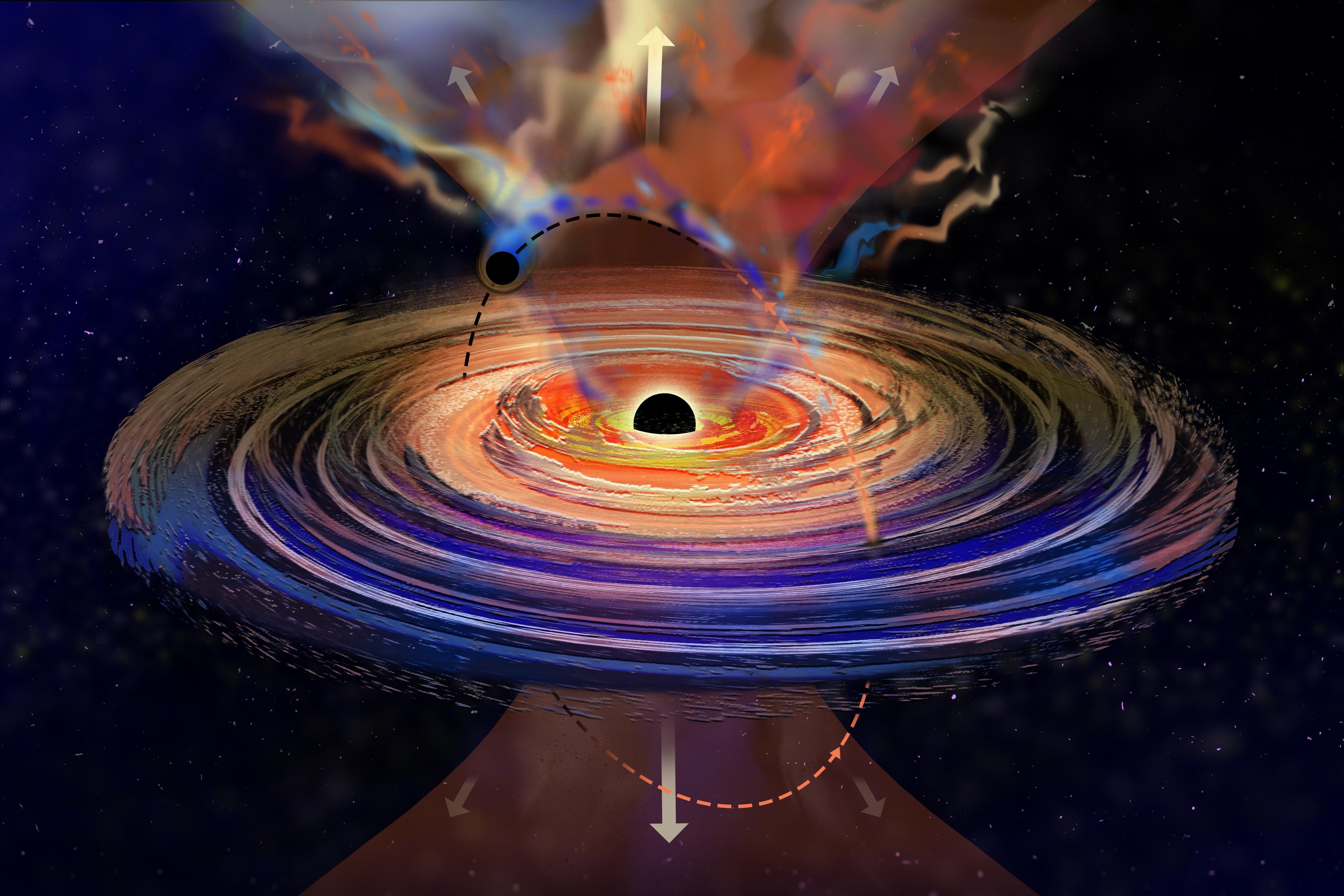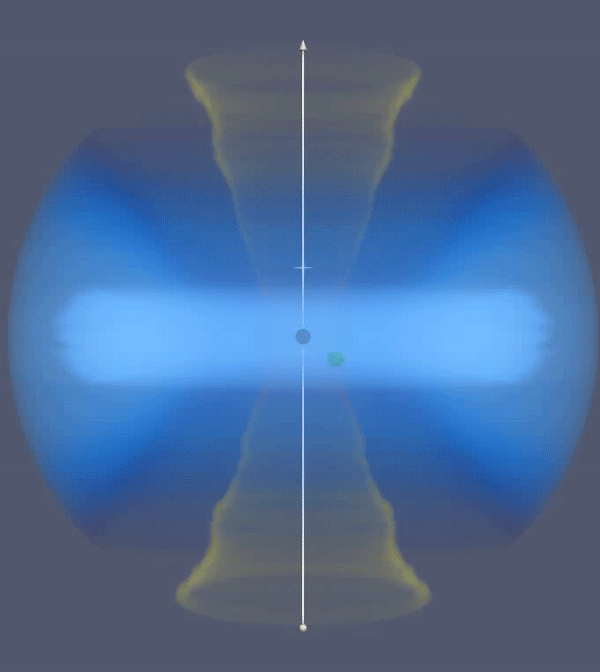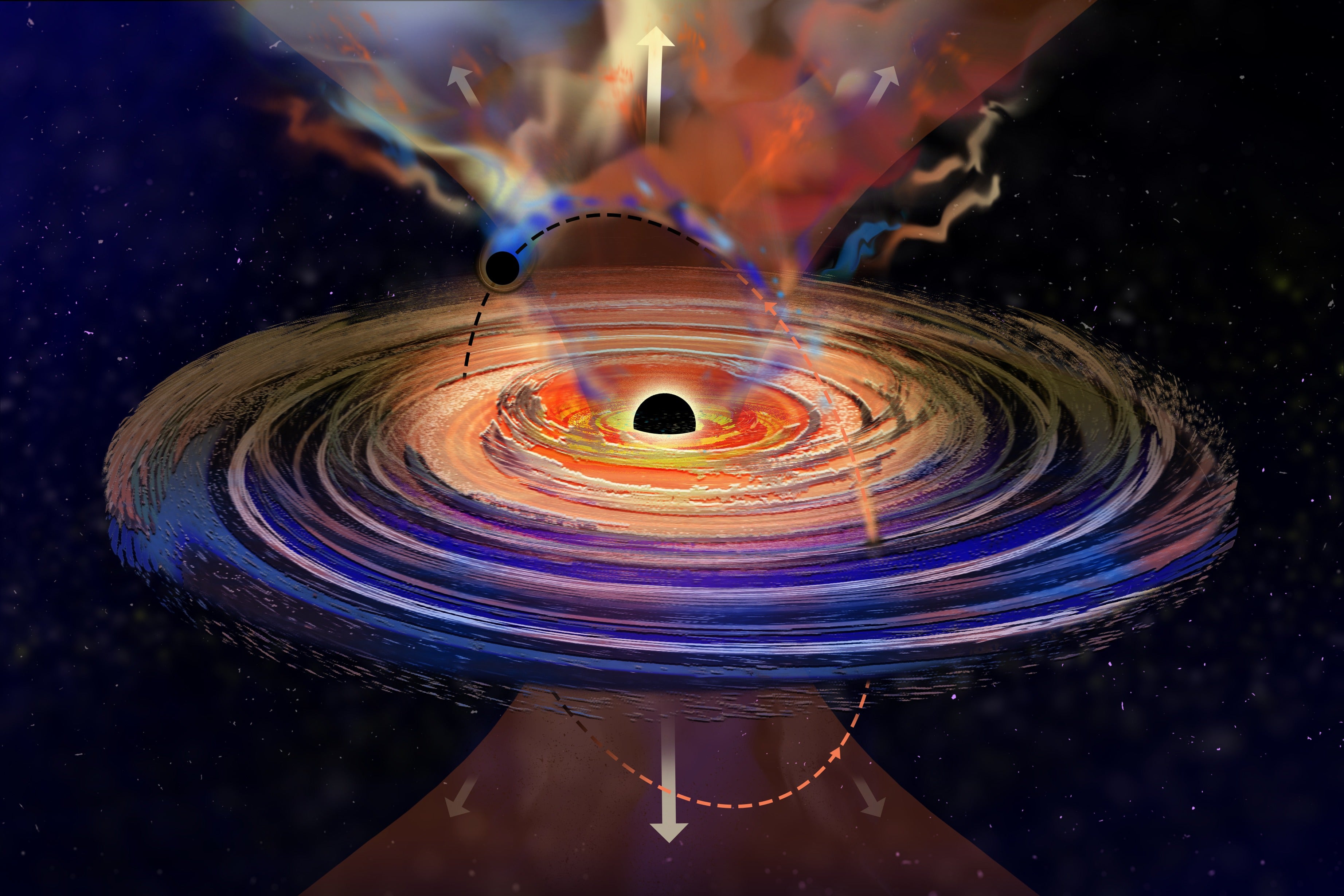
Just a few years ago, in a galaxy 848 million light-years away, astronomers witnessed something strange happen.
The supermassive black hole (SMBH) at the center of this galaxy was chugging along just fine, steadily gobbling up matter that fell into it. But in December 2020, the galaxy suddenly flared up as it feasted on a wayward star and became 1,000 times brighter — only to develop an odd, steady flicker. For four months, until the outburst eventually faded, the galaxy dimmed slightly every 8.3 days — a behavior never seen before in a SMBH outburst.
And after some forensic investigation, astronomers think they know why: This supermassive black hole has a smaller companion black hole zipping around it, kicking up dust every time it goes by.
In a paper published Mar. 27 in Science Advances, an MIT-led team reported on the strange sequence of events.
This binary system of black holes is the first known to contain an SMBH and an intermediate-mass black hole (IMBH). IMBHs are thought to be common in the universe but have proved difficult to find — the first direct detection of an IMBH was only made in 2020. Researchers hope that this flickering behavior is a signature that could lead to the discovery of many more binary systems featuring IMBHs.
The find also shakes up our thinking of what the environment at the core of a galaxy looks like. Instead of a simple disk of matter surrounding the central black hole, steadily swirling across its event horizon, the centers of galaxies could host multiple black holes of different sizes, leading to more complex feeding behavior.

A flash in the night
The initial flare was likely caused by the supermassive black hole tearing apart and gorging on a star that wandered too close to it — what astronomers call a tidal disruption event. Dubbed ASASSN-20qc, it was identified by the All-Sky Automated Survey for Supernovae, a global network of telescopes that looks for bright flashes across the sky every night. After ASASSN-20qc was first spotted by the network in December 2020, astronomers trained a variety of space-based telescopes on the object. (Big explosions or energetic events typically shine brightest in X-ray, which can’t be observed from the ground.)
“When I looked at with X-rays […] I was like, ‘OK, cool, you know, whatever X-ray detection,’ but when I looked closer, what we found was, there’s some interesting signal within the X-ray spectrum that appeared to be showing these regular modulations repeating every 8.3 days,” says Dheeraj R. Pasham, an Einstein Fellow at MIT and lead author of the paper.
After gathering a stream of data, the team looked at a number of scenarios. These included a change in how the inner disk rotates, clumpy matter falling into the black hole, or light being reflected in odd ways by material in the region.
But none of these scenarios that the team considered could create the kind of flickering seen in ASASSN-20qc. That’s when the team realized the likeliest culprit: a second black hole.

While the main, larger black hole is millions of times the mass of the Sun, this intermediate-sized black hole is mere hundreds or thousands of times the mass of the Sun. As the IMBH orbited the larger black hole, it passed through the surrounding accretion disk and kicked up some dust that blocked our view of it, causing it to dim. (It probably stole a little off the plate of the SMBH in the process.)
Pasham says that while looking for possible culprits as he reduced the data, they came across a paper from a group of Czech astronomers proposing a theoretical scenario just like this, where “there is a supermassive black hole with an accretion disk and then the secondary object that is going around,” Pasham says. “Every time it punches through, you should see these kind of absorption features during every cycle or outflows.”
It lined up perfectly with what the team had observed, so Pasham’s team and the Czech authors — after several meetings and some simulations — discovered that the kinds of features seen here could only be caused by an IMBH.
More to come
The IMBH is likely in its final days, astrophysically speaking. It will eventually merge with the central black hole within tens of thousands or millions of years, depending on the mass of the black hole. (Because these objects are so distant, it’s hard to determine how massive they are.)
But the team thinks that such systems are commonplace, and they have already found another dozen or so candidate events with similar features. Currently, they’re working on observing these objects from the ground and with X-ray space telescopes.
Light isn’t the only way these systems can be studied. Because these objects will continue to spiral closer to each other until they merge, they will produce gravitational waves — ripples in the fabric of space-time caused by powerful events.
Mergers of large black holes produce gravitational waves that are too long for current technology to detect. Ground-based facilities like the Laser Interferometer Gravitational-wave Observatory (LIGO) can only detect mergers of stars with masses ranging from a few to a few dozen times the mass of the Sun.
But ESA’s Laser Interferometer Space Antenna (LISA) mission should be able to detect these gravitational waves from space, Pasham says, allowing astronomers insight into what happens when huge black holes merge.
“For one of the systems, we predict that it could be detectable with the LISA in 2037,” Pasham says.









